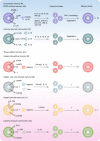Tissue-resident memory-like ILCs: innate counterparts of TRM cells
- PMID: 31286412
- PMCID: PMC6954904
- DOI: 10.1007/s13238-019-0647-7
Tissue-resident memory-like ILCs: innate counterparts of TRM cells
Abstract
Innate lymphoid cells (ILCs) are defined as lymphocytes that lack RAG recombinase and do not express diverse antigen receptors; however, recent studies have revealed the adaptive features of ILCs. Mouse cytomegalovirus (MCMV)- and cytokine-induced memory natural killer (NK) cells circulate in the blood and are referred to as conventional memory NK cells. In contrast, virus- and hapten-induced memory NK cells, hapten-induced memory ILC1s, and cytokine-induced memory-like ILC2s exhibit long-term residency in the liver or lung, and are referred to as tissue-resident memory ILCs. Considering their similar migration patterns and memory potential, tissue-resident memory ILCs could be regarded as innate counterparts of resident memory T (TRM) cells. Both tissue-resident memory ILCs and TRM cells share common characteristics in terms of dynamics, phenotype, and molecular regulation. The emergence of ILC memory expands the basic biology of ILCs and prompts us to re-examine their functions in disease progression. This review discusses the evidence supporting tissue-resident memory NK cells and other memory ILC subsets, compares them with TRM cells, and highlights key unsolved questions in this emerging field.
Keywords: TRM cells; immunological memory; innate lymphoid cells; tissue-residency.
Conflict of interest statement
Xianwei Wang, Zhigang Tian, and Hui Peng declare that they have no conflict of interest. This article does not contain any studies with human or animal subjects performed by the any of the authors.
Figures

Similar articles
-
The Roles of Liver-Resident Lymphocytes in Liver Diseases.Front Immunol. 2019 Jul 16;10:1582. doi: 10.3389/fimmu.2019.01582. eCollection 2019. Front Immunol. 2019. PMID: 31379818 Free PMC article. Review.
-
Dichotomous Regulation of Acquired Immunity by Innate Lymphoid Cells.Cells. 2020 May 11;9(5):1193. doi: 10.3390/cells9051193. Cells. 2020. PMID: 32403291 Free PMC article. Review.
-
Tissue-resident lymphocytes: from adaptive to innate immunity.Cell Mol Immunol. 2019 Mar;16(3):205-215. doi: 10.1038/s41423-018-0192-y. Epub 2019 Jan 11. Cell Mol Immunol. 2019. PMID: 30635650 Free PMC article. Review.
-
Innate lymphoid cell memory.Cell Mol Immunol. 2019 May;16(5):423-429. doi: 10.1038/s41423-019-0212-6. Epub 2019 Feb 22. Cell Mol Immunol. 2019. PMID: 30796350 Free PMC article. Review.
-
Heterogeneity of NK Cells and Other Innate Lymphoid Cells in Human and Murine Decidua.Front Immunol. 2019 Feb 8;10:170. doi: 10.3389/fimmu.2019.00170. eCollection 2019. Front Immunol. 2019. PMID: 30800126 Free PMC article. Review.
Cited by
-
MiR-142-3p Regulates ILC1s by Targeting HMGB1 via the NF-κB Pathway in a Mouse Model of Early Pregnancy Loss.Curr Med Sci. 2024 Feb;44(1):195-211. doi: 10.1007/s11596-024-2833-y. Epub 2024 Feb 23. Curr Med Sci. 2024. PMID: 38393528
-
The Roles of Tissue-Resident Memory T Cells in Lung Diseases.Front Immunol. 2021 Oct 11;12:710375. doi: 10.3389/fimmu.2021.710375. eCollection 2021. Front Immunol. 2021. PMID: 34707601 Free PMC article. Review.
-
Human Innate Lymphoid Cells in Influenza Infection and Vaccination.Crit Rev Immunol. 2021;41(3):57-82. doi: 10.1615/CritRevImmunol.2021040801. Crit Rev Immunol. 2021. PMID: 35378011 Free PMC article. Review.
-
Decoding the multidimensional signatures of resident and expanded natural killer cells generated from perinatal blood.Am J Cancer Res. 2022 May 15;12(5):2132-2145. eCollection 2022. Am J Cancer Res. 2022. PMID: 35693070 Free PMC article.
-
Critical Roles of Balanced Innate Lymphoid Cell Subsets in Intestinal Homeostasis, Chronic Inflammation, and Cancer.J Immunol Res. 2019 Nov 5;2019:1325181. doi: 10.1155/2019/1325181. eCollection 2019. J Immunol Res. 2019. PMID: 31781671 Free PMC article. Review.
References
-
- Arase H, Mocarski ES, Campbell AE, Hill AB, Lanier LL. Direct recognition of cytomegalovirus by activating and inhibitory NK cell receptors. Science. 2002;296:1323–1326. - PubMed
-
- Arnon TI, Achdout H, Lieberman N, Gazit R, Gonen-Gross T, Katz G, Bar-Ilan A, Bloushtain N, Lev M, Joseph A, et al. The mechanisms controlling the recognition of tumor- and virus-infected cells by NKp46. Blood. 2004;103:664–672. - PubMed
-
- Artis D, Spits H. The biology of innate lymphoid cells. Nature. 2015;517:293–301. - PubMed
Publication types
MeSH terms
LinkOut - more resources
Full Text Sources

